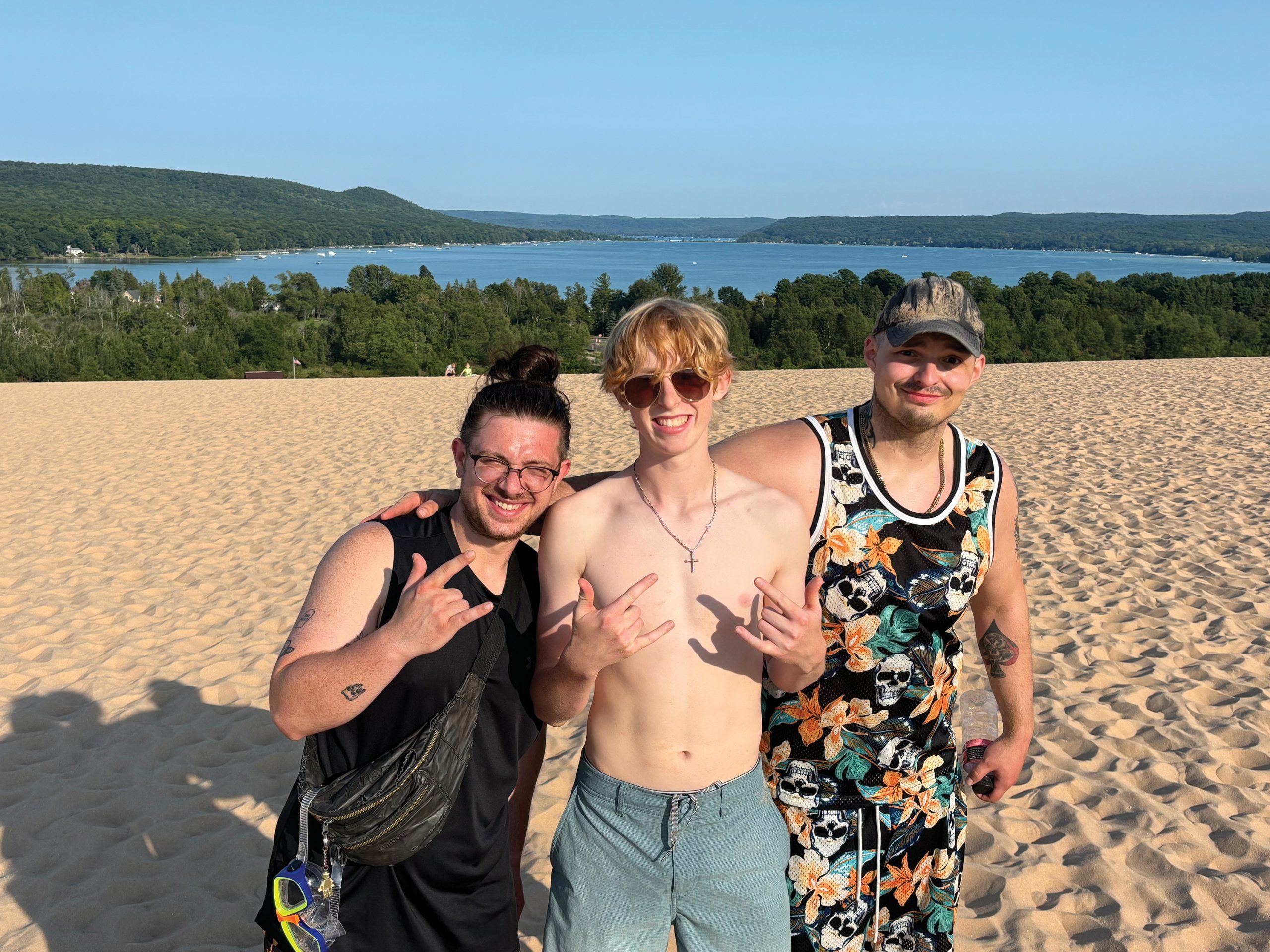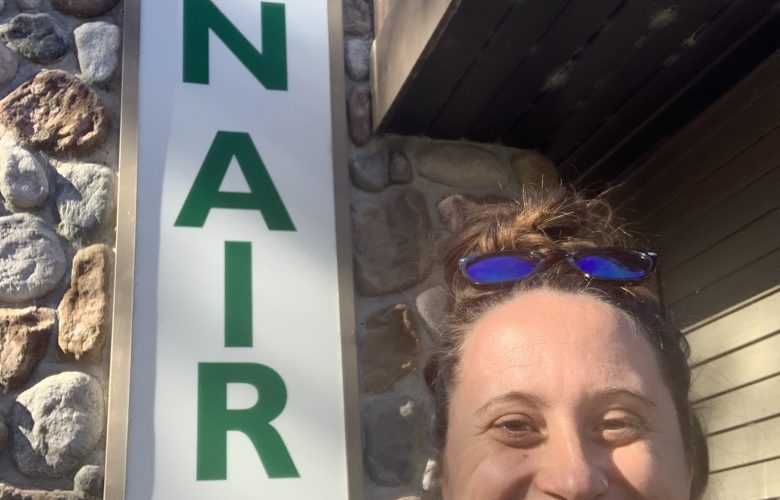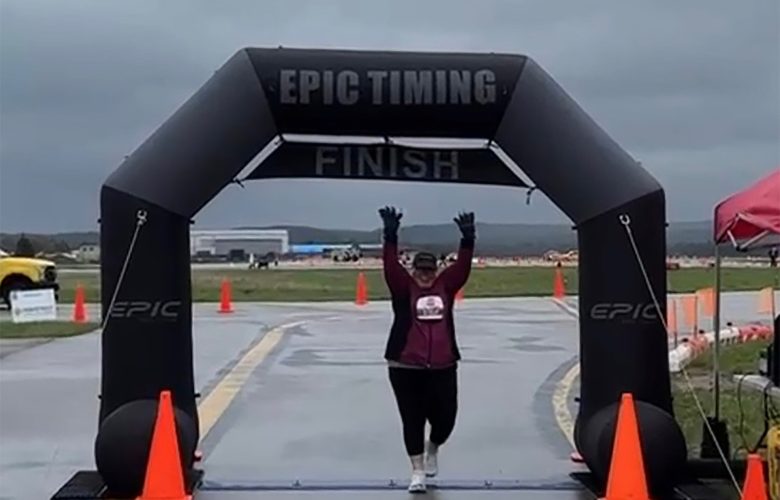The importance of being prepared at Sleeping Bear Dunes
By Aubrey Ann Parker
Current Editor
On Tuesday, August 13, around 3 p.m. in the afternoon, Russ Patterson and his son, Brody (16), of Frankfort set off from the parking lot of the Dune Climb in Sleeping Bear Dunes National Lakeshore. They planned to hike to Lake Michigan for a swim and then hike back to the truck—a three-mile round trip across five big dunes that generally takes about three hours, which they had done several times before.
Only this time, the trip would not be quite so smooth.
“We were probably 15 minutes away from Lake Michigan when we passed these two guys,” Russ says. “At that time, they asked if we had any extra water. So we gave them some of our water and recommended that they turn around; we wished them luck getting back to the parking lot, didn’t think too much more about it, and went on our way.”
The Pattersons made it to the big lake and swam for about 20 minutes in the cool waters on that hot, 80-degree day.
“On our way back, about halfway between the lake and the parking lot, we ran into them again,” Russ says. “They were at the foot of the steepest climb, and we could tell they were really in trouble now.”
Brody agrees:
“My dad and I were like, ‘Oh no, that’s not good,’ to see them still walking, because they were going real slow, and they looked really dehydrated.”
The two men were Ryan and Chad from Cincinnati, Ohio. This was their first time visiting Sleeping Bear Dunes National Lakeshore, and they had set out on this hike after having watched a video on Tik-Tok that had made the journey from the Dune Climb to Lake Michigan look easy.
Not So Easy
According to the Park’s website, however, “this is the most strenuous hike in the Lakeshore.” Recommendations are two liters of water per person, salty snacks, footwear, sunscreen, sun protection, a plan, and a buddy.
By this point, Ryan and Chad had been out for about four and a half hours with very little fluids and no food, and Ryan’s heart was racing. They had brought only a small bottle of water with them, and it was completely drained. Both men were very pale.
“We asked if they wanted us to walk back with them,” Russ says, to which Chad responded, “Yes, yes, please, my friend is scaring me.”
The Pattersons gave the Ohioans fruit chews for a bit of nutrition and the remaining fluids that they had brought for their own hike. At this point, Brody—a junior on the Frankfort High School cross country team who also plays U16 AA travel hockey out of Traverse City—said:
“Hey Dad, do you have any money in the truck? Give me the keys; I need to run back to the parking lot and get these guys something from the vending machine; some drinks, some salt, some electrolytes. They’re in trouble.”
While Brody ran off, Russ stayed with the pair, and they continued to walk about 20 steps at a time, slowly working their way up the big climb in front of them, then the next one.
At one point, Ryan, who was struggling the most, turned to the others and said, “I think we need to call 911.”
Only—as most of us locals know about the shoreline—nobody had reception to get a call out.
Fortunately, Russ was able to get a text to his wife, Victoria, who immediately called 911 and filled them in. Emergency services put her in touch with Park Ranger Nate Mazurek, who then called Russ—and, thankfully, that call was able to come through, despite the shoddy cell service that goes in and out along the hike.
Mazurek asked Ryan if he needed to get emergency equipment, like an all-terrain vehicle (ATV), onto the dunes to get to them and give him a ride back to the parking lot.
Chad and Ryan were worried about the costs associated with calling in the rescue services, and they wanted to keep trying on their own for a little while; by the time that Mazurek called back a second time to check in, Brody had returned with supplies, so Ryan responded:
“I’m feeling much better. I think I can make it out.”
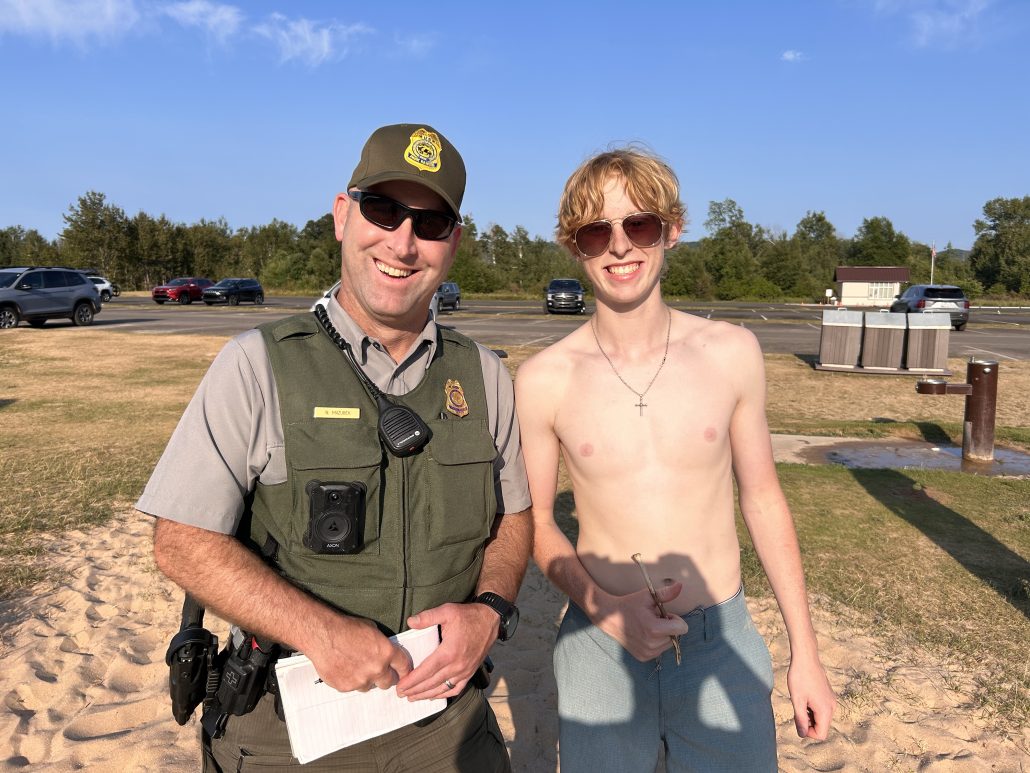
Brody’s Journey
“I was jogging up the steeper hills, and then I would fast jog or even sprint down the hills and in the flat places,” Brody says of his trek to the parking lot. “It was tough on the hills, I would walk, but I didn’t want to stop to take breaks, I just kept moving. I got to the truck, sped over to the vending machines, and picked up a red Powerade, a lemonade, and a water. I also grabbed a trail mix, because of the salt in it.”
At this point, Brody had to face the steep Dune Climb—a “284-foot-high wall of glistening white sand,” according to the Park’s website—which he says he “speed-walked” up.
“At the top, I actually drank the bottle of water, because I needed it,” Brody says. “Then I jogged again, because the first part is pretty flat, then jogged up to the top of the first hill, down another, and I saw my dad at the top of the next hill. He was looking for me at this point, and I was gassed; I didn’t have much left in me. So I tossed him the stuff, and he ran to give it to them.”
Chad and Ryan drank nearly all of the Powerade and lemonade, while sitting.
“I could see immediately that they were getting their health back, that they were more hydrated,” Brody says, “And they seemed more calm and happy. Then we started to slow-walk back, about 25-50 yards at a time. We’d sit down in the shade, and they’d drink some more of whatever we had left.”
This is when the second call from Ranger Mazurek came in.
“They both said, ‘We’re good, we’ve got drinks in us, we feel a lot better,’” Brody says.
On the way back down, the Pattersons were telling the Ohioans jokes and stories, to keep their minds occupied. Ranger Mazurek had been driving across the county to get to them, and he called a third time to say that he was getting close to the parking lot, while the foursome were about 15 minutes from the Dune Climb; Mazurek got out of his vehicle just as the group was getting off the dunes.
Mazurek checked on Ryan, who expressed that he was embarrassed, that he couldn’t believe it had happened; Chad, meanwhile, grabbed some more beverages from the vending machine for himself and his friend. It had been nearly six hours since they had first left the parking lot.
“It was just me today,” Mazurek later told the Pattersons. “I don’t know if we could even have gotten the ATVs up there. You basically did my job for me, running those supplies up to them. It sounds like they were close to heat stroke and exhaustion, that they were unprepared and in serious trouble. We would have considered this to be a Priority 1 situation, and I would have hiked up there and waited with them for emergency medical responders.”
Later that day, Mazurek texted Russ:
“I want to thank you and Brody again for the help you both provided to Ryan and Chad. Your decision to get involved definitely made a huge difference and was crucial for the positive outcome. Ryan and Chad were very grateful for your help and are certain Ryan would’ve left in an ambulance if they hadn’t met you. Good work!”
Sleeping Bear Dunes National Lakeshore superintendent Scott Tucker says:
“Looking at the notes from what transpired that day, [Ranger] Nate [Mazurek] basically said, ‘This kid had his head square on and was the hero of the day.’ The quick actions he and his father took saved a full response that would have included firefighters from the Glen Lake Department, as well as Lakeshore employees; it could have turned into a lengthy search and rescue.”
Safety Measures
In recent years, Sleeping Bear Dunes National Lakeshore has welcomed around 1.6 million visitors annually; obviously the majority of these people are coming from out of town, given the relatively small population in our region.
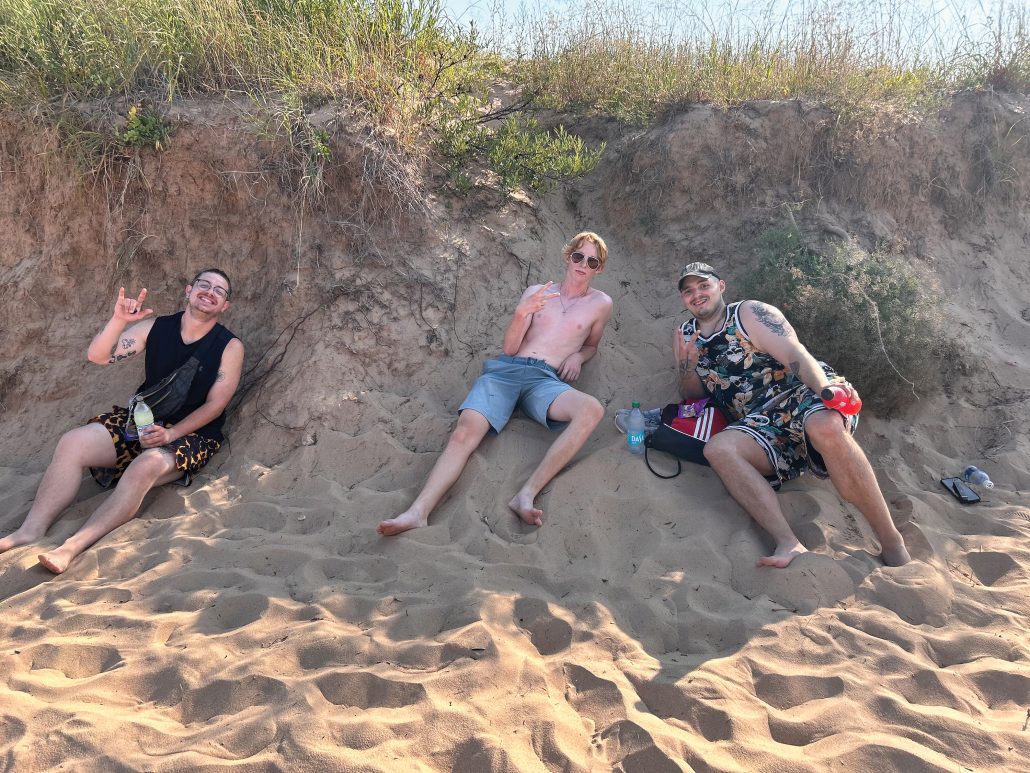
So how does the Park try to get the word out to visitors who might not know about the potential dangers, like attempting to hike from the Dune Climb to Lake Michigan without enough supplies?
“Brody and I have done this hike many times,” Russ says. “When we got to the top of the Dune Climb this time, though, there was a person at the top in a bright yellow shirt with a clipboard. She said, ‘Hey guys, it’s a hot day. Do you have enough water? What’s your plan?’ She was advising people on what to do, and I have never seen that before.”
This woman was a volunteer with the Preventative Search and Rescue program, which began in 2014 via the Friends of Sleeping Bear Dunes. At that time, there were 31 search-and-rescue missions and 56 calls to 911 at the Dune Climb and the Lake Michigan Overlook at Pierce Stocking Drive between Memorial Day and Labor Day.
With summer not yet over, stats for this year are not quite complete, but between that same time frame in 2023, there were only 11 search and rescues and seven calls to 911 from the Dune Climb and Pierce Stocking Drive, which is a significant reduction. Moreover, four of last year’s calls were made by PSAR volunteers who had made early contact with visitors, which helped to reduce the time between the incident and when first responders arrived. (It is notable that PSAR volunteers are trained to educate visitors about planning, protective clothing, etc. at these two popular spots, but they are not tasked with search and rescue themselves; that is left to the professionals.)
In 2022 and 2023, PSAR made contact with more than 30,000 Park visitors each year—like the woman in the yellow shirt made contact with the Pattersons that day—and has helped to increase visitor safety and reduce emergency calls. Volunteers educate visitors on trail and water conditions, as well as watching for visitors in need of assistance.
Additionally, the Friends of Sleeping Bear Dunes have been increasing signage at these more harrowing parts of the Park—in part, thanks to donations from the public.
In fact, just two days after the Pattersons helped Ryan and Chad, MLive published an article online titled, “So what’s the deal with those $3,000 rescues at Sleeping Bear Dunes,” which outlines white signs at Overlooks #9 and #10 warning people that, if they go down the 450-feet dune to Lake Michigan at Pierce Stocking and can’t get back up by themselves, they may have to pay up.
Randomly on the same day as Brody’s rescue mission to the Dune Climb parking lot, the Glen Lake Firefighters’ Facebook page mentioned that pictures of the Pierce Stocking signs had gone a bit viral, so they were putting out a public safety announcement (PSA):
“Thanks to social media, it seems these signs located at the top of Pyramid Point, and the Overlooks #9 and #10, are drawing quite a bit of attention once again. So we’re here to attempt to shed some clarity… rescuing someone from the dunes is a coordinated effort between the National Park Service and [Glen Lake Fire Department]. In order to effectively rescue someone, it takes all on-duty personnel from both stations, as well as several NPS rangers. While we are performing these rescues, we would need mutual aid from outlying areas to respond to our taxpayers, should additional emergencies arise. This is one reason for the rescue charges… additionally, equipment needed for rescues are expensive, and the sand is very hard on this equipment.”
Rescue costs—of which there are three levels, ranging from around $700 to $2,700, depending on how many people and what equipment are needed—went up in 2019, according to MLive, after high water levels made it too difficult to rescue people with a beach cart. For instance, rescuers had to rappel 200 feet down to rescue two people at the Treat Farm Trail in April 2022, and a rescue like that takes a lot of wear and tear on the rope, according to the Glen Lake Fire Department.
“Since putting these signs in place, rescues at [Pierce Stocking] have gone from a daily occurrence during the summer months to less than a weekly occurrence,” the Facebook PSA says. “This summer, we have responded to the #9 and #10 Overlooks only eight times, with half of those responses involving rescues.”
Humble Hero
In all, 16-year-old Brody Patterson did about five miles on the dunes that day—and more than half of that was running, not walking.
But as of this interview on Thursday, August 22, he still had not told his cross-country coach, despite that practice started on Monday.
In fact, Brody does not think he has told anyone, until now.
In an age when a Tik-Tok influencer has made the three-hour Dune Climb-to-Lake-Michigan hike look too easy through an unrealistic (over)sharing that convinces two out-of-town Park visitors to undertake it themselves without the proper preparation in place, it is the local teenager who performed a truly heroic and attention-grabbing act of service, yet has not told any of his friends—or his own social media followers.
There is more than a dose of irony to this.
“He’s a pretty humble guy,” Russell says of Brody. “He didn’t feel the need to promote it.”
Meanwhile, Matt Stapleton, principal at Frankfort High School says:
“It doesn’t surprise me at all that Brody jumped in to help. He is a respectful and well-mannered young man who gets along well with his classmates and teachers. I have seen Brody, on multiple occasions at the school, offer his help or assistance to staff members—including me)—without any solicitation. He is that kind of kid.”
His father agrees.
“Full credit goes to my son for, number one, that he had the calm to say, ‘Dad, these guys need fluid.’ I’m a proud papa. He came up with that all on his own,” Russell says. “And number two, that he had the physical stamina to do that three-mile jog/sprint. He was pretty damn sore the next couple of days.”
Brody says:
“Two guys needed help; I just did what I hope anyone else would do.”
Visit FriendsOfSleepingBear.org/wp-content/uploads/2023/05/PSAR-Volunteer-Job-Description.pdf or FriendsOfSleepingBear.org/Volunteer-Registration/ online to learn more about becoming a PSAR volunteer, or contact Jesse Lewit, PSAR coordinator by sending an email to jlewit1128@gmail.com.
Featured Photo Caption: Chad (left) and Ryan (right) of Ohio got into trouble on the hike from the Dune Climb to Lake Michigan when they did not bring enough water, so 16-year-old Brody Patterson (center) ran back to the parking lot and got supplies from the vending machines—close to three miles for him, round trip. Chad and Ryan almost immediately felt better, as can be seen by the smiles on their faces in this picture when they finally made it back to the Dune Climb above the parking lot. Park rangers say that the Frankfort High School cross country runner helped to avert potential disaster that day. Photo by Russ Patterson.

